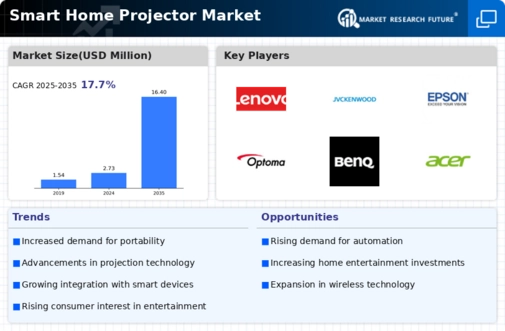Market Trends
Key Emerging Trends in the Smart Home Projector Market
The Smart Home Projector Market is experiencing dynamic trends that are shaping the future of this industry. These trends reflect the evolving needs and preferences of consumers, as well as advancements in technology. Let's explore some of the key trends driving the Smart Home Projector Market.
Integration with Smart Home Ecosystems: One prominent trend in the Smart Home Projector Market is the increasing integration of projectors with broader smart home ecosystems. Consumers today seek seamless connectivity and interoperability between various smart devices in their homes. Smart projectors are now designed to integrate with voice assistants, smart lighting, security systems, and other connected devices, providing users with a unified and convenient smart home experience.
Enhanced Connectivity and Wireless Capabilities: With the proliferation of wireless technologies, Smart Home Projectors are now equipped with advanced connectivity options. Wi-Fi and Bluetooth capabilities allow users to effortlessly stream content from their smartphones, tablets, or laptops directly to the projector. This wireless connectivity enhances convenience and eliminates the need for cumbersome cables, contributing to a clutter-free and aesthetically pleasing home environment.
Focus on Energy Efficiency: As consumers become increasingly environmentally conscious, there is a growing emphasis on energy-efficient solutions in the Smart Home Projector Market. Manufacturers are incorporating energy-saving features such as LED light sources and power-efficient components. These energy-efficient projectors not only contribute to sustainability but also result in cost savings for users over the long term.
Advancements in Display Technology: The Smart Home Projector Market is witnessing continuous advancements in display technologies. High-definition (HD), 4K, and even 8K resolutions are becoming standard features in modern smart projectors, delivering crisp and immersive visuals. Additionally, improvements in color accuracy, contrast ratios, and brightness levels contribute to an enhanced viewing experience, making smart projectors a compelling choice for home entertainment.
Compact and Portable Designs: The trend towards compact and portable designs is gaining traction in the Smart Home Projector Market. Consumers value the flexibility to set up their projectors in different rooms or take them outdoors for movie nights or presentations. Compact, lightweight, and portable smart projectors cater to the modern lifestyle, providing users with versatility and convenience.
Smartphone Control and Mobile Apps: Smart Home Projectors are increasingly designed to be controlled through dedicated mobile apps. Users can adjust settings, change input sources, and even control smart projector functions remotely using their smartphones. This trend aligns with the growing reliance on mobile devices for seamless home automation control.
Augmented Reality (AR) and Interactive Features: Some Smart Home Projectors are incorporating augmented reality (AR) and interactive features, allowing users to interact with projected content. This can be particularly appealing for educational purposes, gaming, or interactive presentations. The integration of sensors and gesture control enhances user engagement and introduces a new dimension to home entertainment.
Customization and Personalization: Personalization features are becoming more prevalent in the Smart Home Projector Market. Users can customize settings, create personalized profiles, and even tailor the projected visuals to suit their preferences. This trend caters to the diverse needs and tastes of users, enhancing the overall user experience.
Affordability and Market Accessibility: As technology advances, the cost of manufacturing smart projectors has decreased, leading to more affordable options in the market. This trend promotes accessibility, making Smart Home Projectors available to a broader consumer base. Affordability, coupled with an expanding range of features, drives market growth and adoption.
Rise of Hybrid Projectors: Hybrid projectors that combine traditional projection capabilities with additional functionalities are gaining popularity. Some smart projectors now integrate features such as built-in speakers, streaming platforms, and even voice control. This convergence of technologies in hybrid projectors caters to users looking for all-in-one solutions in their smart home setups.
The Smart Home Projector Market is marked by a dynamic interplay of technological advancements, consumer preferences, and the broader trends shaping the smart home industry. The future holds exciting possibilities as smart projectors continue to evolve, offering innovative features and enhancing the overall smart home experience for users around the world.








Leave a Comment